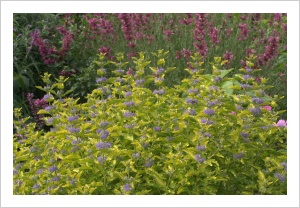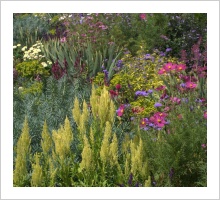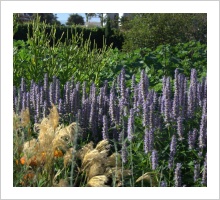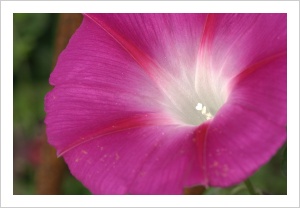Morning Glory
The morning-glory
Has captured my well-bucket.
I will beg water.
Chiyo-Jo 1703-1775
Two years ago we made a new flower border in an area where we had been growing vegetables. At this time of year, in early February, it’s looking really beautiful. Whilst we have many perennials and quite a few flowering shrubs in the border it’s the annuals that are making the most brilliant display at the moment.
Twining around a metal frame are two morning-glory seedlings. The flowers flare like a tuba. One is deep pink with five red spokes on the interior of the white throated bloom and five white spokes on the exterior. The stigma and stamens are white. The other seedling has midnight purple-blue flowers with red interior spokes and pink exterior ones. They are such simple flowers and yet looked at closely are heart-stoppingly beautiful.
I planted a dozen or more morning-glory seedlings last spring but most were grazed by rabbits early on and are only just now getting going.
 The foliage of most yellow or lime-green leaved shrubs burns here during summer but one of the bluebeards, Caryopteris x clandonensis ‘Lisaura’, sparkles even during such awful heatwaves as last summer’s week of 45C days. Growing about a metre tall by as much wide ‘Lisaura’ has lemon foliage when young aging to chartreuse at flowering time. I cut its stems back halfway during winter. This encourages strong vigorous new growth and as the soft mauve-blue bluebeards are produced in the leaf axils of current seasons stems gives a longer flowering period.
The foliage of most yellow or lime-green leaved shrubs burns here during summer but one of the bluebeards, Caryopteris x clandonensis ‘Lisaura’, sparkles even during such awful heatwaves as last summer’s week of 45C days. Growing about a metre tall by as much wide ‘Lisaura’ has lemon foliage when young aging to chartreuse at flowering time. I cut its stems back halfway during winter. This encourages strong vigorous new growth and as the soft mauve-blue bluebeards are produced in the leaf axils of current seasons stems gives a longer flowering period.
‘Lisaura’, raised by British nurseryman Peter Catt, was presented with the Royal Horticultural Society’ Award of Garden Merit in 2007.
Caryopteris are unlikely candidates for heat tolerance coming as they do from the Himalayas, Mongolia, China and Japan. They are though amongst the toughest of all shrubs and their late summer and early autumn flowering period makes them beautiful additions to mixed borders.
 There are several patches of the lime-green flower plumes of the annual Celosia argentea ‘Sylphid’ as they combine so well with the soft mauve powder puffs of Ageratum ‘Blue Planet’ and other mauve, purple and magenta flowers which are the dominant element in this border. ( Lagos Spinach, Celosia argentea, is so easy to grow and is so resistant to disease that it is grown as a leaf vegetable in some tropical countries such as Nigeria, where it is also known as ‘soko yokoto’ which roughly translates as “make husbands fat and happy”.)
There are several patches of the lime-green flower plumes of the annual Celosia argentea ‘Sylphid’ as they combine so well with the soft mauve powder puffs of Ageratum ‘Blue Planet’ and other mauve, purple and magenta flowers which are the dominant element in this border. ( Lagos Spinach, Celosia argentea, is so easy to grow and is so resistant to disease that it is grown as a leaf vegetable in some tropical countries such as Nigeria, where it is also known as ‘soko yokoto’ which roughly translates as “make husbands fat and happy”.)
 It’s a wonder to me that a genus with as many marvellous plants in it as the Hummingbird Mints, Agastache, can have been so long neglected by gardeners. The Korean species, A. rugosa, has been cultivated for a long time it’s true but the North American species, with the exception of A. mexicana, have only been seen in gardens outside of western USA for the past couple of decades. There are five or six different clones growing in this border. Agastache ‘Blue Fortune’, with its mauve-blue bottle brush flowers held stiffly upright on 120cm tall stems, is one of the best and flowers for many months from mid-summer until well into the autumn.
It’s a wonder to me that a genus with as many marvellous plants in it as the Hummingbird Mints, Agastache, can have been so long neglected by gardeners. The Korean species, A. rugosa, has been cultivated for a long time it’s true but the North American species, with the exception of A. mexicana, have only been seen in gardens outside of western USA for the past couple of decades. There are five or six different clones growing in this border. Agastache ‘Blue Fortune’, with its mauve-blue bottle brush flowers held stiffly upright on 120cm tall stems, is one of the best and flowers for many months from mid-summer until well into the autumn.
The gardens at Lambley are looking wonderful at the moment and are well worth a visit.

